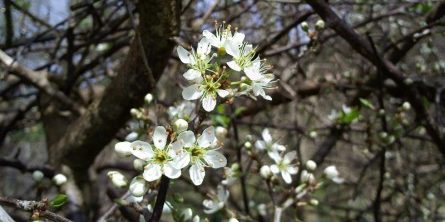THE LEAFLET

Tree of the Month: Hawthorn
The Hawthorn tree (Crataegus sp.) harkens back to the old woodlands, farmlands, and estates of yore. It is a tree of diverse species with many forms and characteristics. Its wildness is exemplified most by the natural forms with long, stout thorns, and twisting and turning branches that form thickets telling woodland wanderers, “do not tread here.” While wildness can be a virtue, you might prefer the more homely cultivars that have been selected over centuries of Hawthorn cultivation. Varieties have been selected to be thornless, columnar, and to have showier flowers and fruit.
The hawthorn grows native all across the temperate regions of the Northern Hemisphere. There are about 220 species native to North America alone. Many species occur only in certain places, giving many regions a native hawthorn they can call their own. Green Hawthorn (Crataegus viridis), with the now popular cultivar “Winter King” is probably the better known of the species native to our region. “Winter King” has a magnificent display of red fruit that persists further into the winter than most varieties. Its form can vary, with some cultivars staying under 10 feet, and some wild varieties getting as large as 45 feet. Hawthorns are generally considered tough species, able to deal with a range of soil conditions and drought, but they tolerate only moderate shade. Being in the rose family, Hawthorns are susceptible to some of the diseases associated with species in that family, though they are considered hardier than their cousins and with a little vigilance this tree should be no problem to grow. A healthy Hawthorn of some species can live as long as 400 years.
Hawthorn has much lore and a variety of historical uses. The traditional Mayday festival of Northern Europe was, in some places, said to fall on the day the Hawthorns bloomed, May 1st. Its alternate name is “Mayhaw.” Hawthorn flowers decorated the woman chosen to be the “May Queen.” Hawthorn fruits, also called “haws” have been used traditionally to make jams and jellies, with the North American varieties said to be sweeter and less astringent than their European counterparts. There is a movement to expand the cultivation of some southeastern varieties of Mayhaw to a broader commercial level. Hawthorn is also prevalent in folk medicine and has been used to counteract high blood pressure, heart failure, and chest pain. Unlike many folk remedies, these effects have recently been substantiated by conventional medical research and marketing of hawthorn extract has followed.
The Latin name Crataegus means “hardness” and refers to the Hawthorn woods durability. It was used in many applications of wood demanding strength, including for the cog teeth in old wooden watermills and machinery. For obvious reasons, the Hawthorn makes for one of the most functional living fences and hedges. When the commons farmland of England was divided up and privatized in the 18th and 19th centuries, the most popular way of enclosing land and keeping others out was to establish a Hawthorn hedge. Livestock can also be contained this way. Hawthorn is also a great wildlife plant, giving food to the birds into the winter.
So don’t let the thorns on some of those Hawthorns scare you off. This tree has a rich cultural and ecological history, is a beautiful addition to any landscape, and it could even improve your health! Look out for its red berries in the winter and its flowers coming this spring (not exactly on Mayday around these parts) with the species map below:
Flickr credit: i-r-paulus.